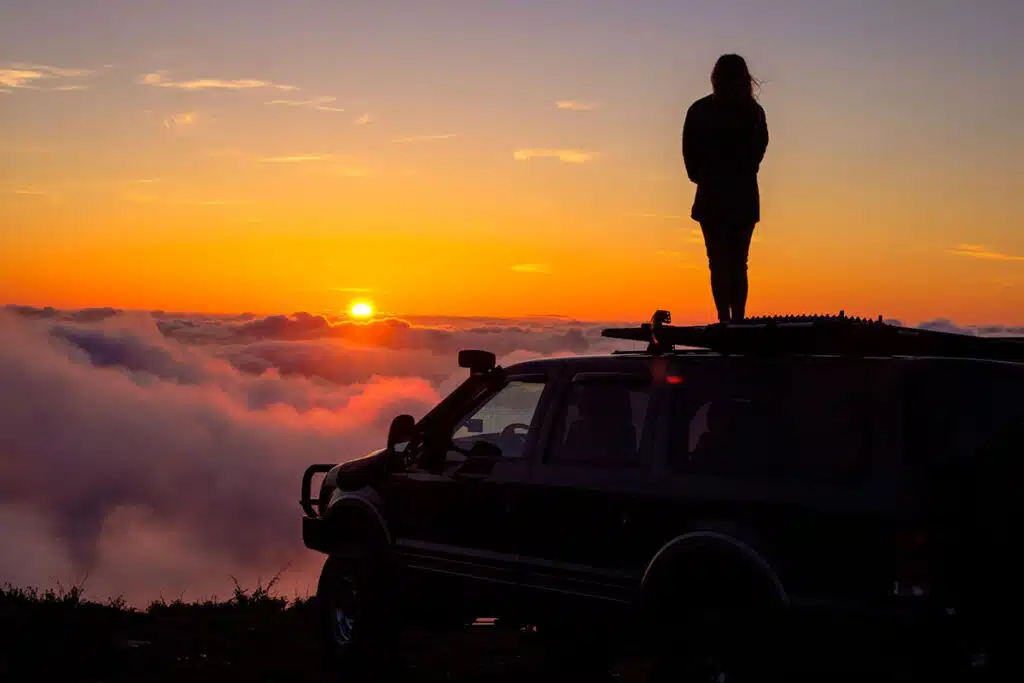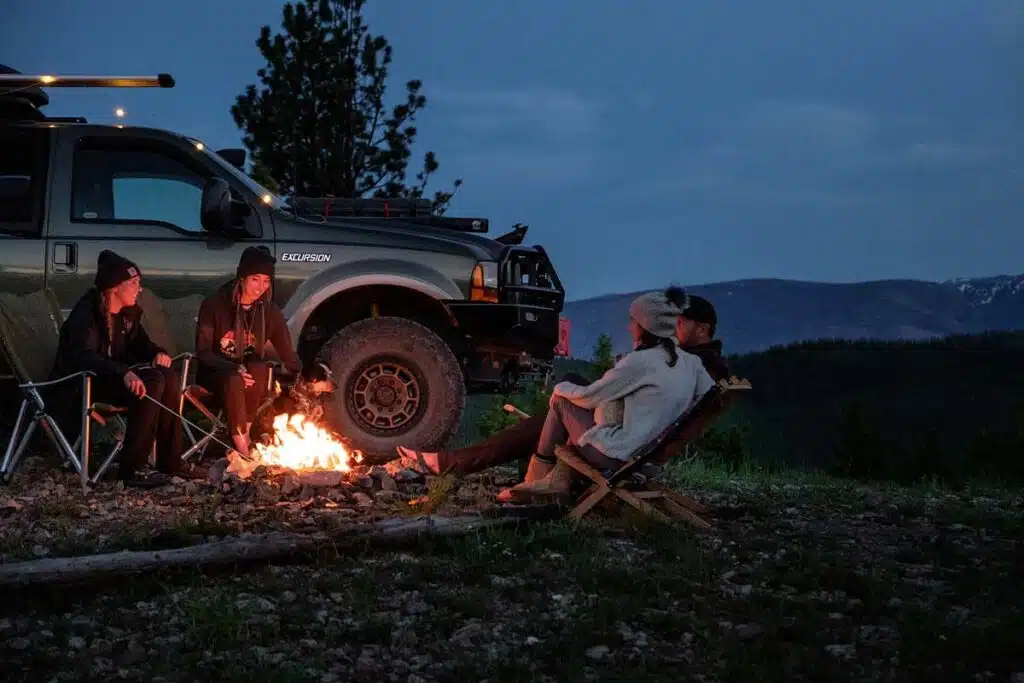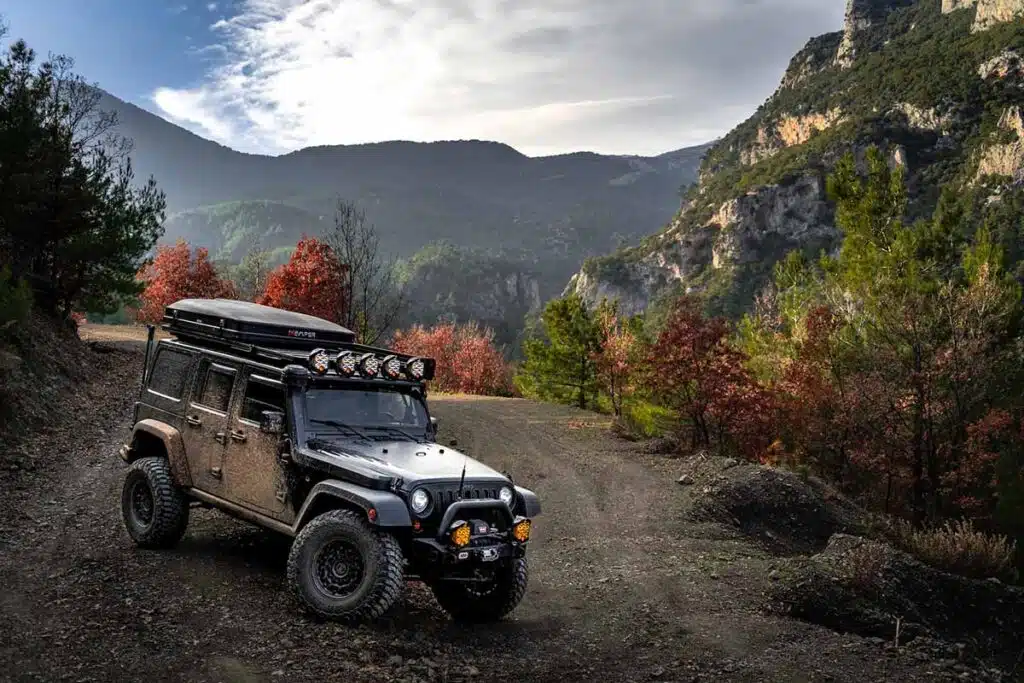Since the early 1900s, the world of outdoor recreation has dramatically evolved — from leisurely biking to paragliding. Some prefer to play it safe and opt for classics. Meanwhile, brave souls with a Carpe diem philosophy go for death-defying extreme sports.
If you are looking for something in between that is fun and screams adventure, you might want to try overlanding.
So, what is overlanding?
Overlanding is a subset of off-roading that entails exploring an area or region in a 4×4 vehicle. It requires thorough planning and spans a few days to years. Depending on your rig, preparedness, skills, and destination, it can break your off-roading spirit or become an adventure of a lifetime.
The number of overlanding enthusiasts sharing their experiences continues to grow — thanks to advancements in tech and communication. Consequently, more people are taking an interest in this outdoor recreation.
If you want to join or are new to the community, you will find the information in this guide extremely useful.

What Is Overlanding?
Overlanding is a recreational activity involving the navigation and exploration of long stretches of unpaved terrain.
Although it is currently considered a hobby and a sport, its original intention was surveying land and “moving livestock over long distances” in the Land Down Under (hence the term ‘overland’). It was not until the mid-1900s that its current form came to fruition.
An overlanding expedition involves driving a four-wheeler over different terrain and for extended periods while being off the grid and self-sufficient for the entirety of the journey.
The last two facets are vital to overlanding and make the venture distinct, as part of an overlander’s objectives is to stay outdoors and cover as much ground for as long as possible with little to no maintenance.
One of the misconceptions about these expeditions is that they only involve going to solitary, remote places. This is far from the truth, as the activity includes interacting with other cultures and overlanding enthusiasts.
Additionally, destinations can be planned to the T or super spontaneous — which is why it usually spans weeks or months.
In the U.S., overlanding is typically done inter-state. But in other parts of the world, it entails crossing borders or state lines.
Given this perspective, covering a range of 50—200 miles per day would be reasonable. But these figures could go up or down at any time, depending on vehicle setup, terrain, and skill level.
Overlanding vs. Camping
Overlanding has been around for a while. However, more and more people are getting acquainted with it for the first time.
Probably because they had some form of previous camping experience, folks new to the pastime tend to mix the two up. In truth, the only thing shared between them is the use of a tent.
Compared to overlanding, camping entails a planned destination site, has a more rigid itinerary, and is done over a few days to a few weeks.
Though in the middle of nature, a typical campsite usually has access to hot showers, clean toilets, picnic tables, and other modern conveniences. It is also not extremely far from retail stores and a hospital (in case an emergency or urgent purchase comes up).
On the other hand, overlanding is more unrestricted and entails multiple destinations (or stopovers). It is in these remote places where campsites are made, which means it is totally off the grid — with overlanders completely reliant on supplies and ‘conveniences’ they have brought with them.
The activity duration is another clear distinction, as camping rarely lasts for months.
But the most outstanding disparity between these hobbies is the planning required. Outside of food and supplies, a camper needs to only think about the destination site, activities they want to join, and equipment they need to bring for those activities.
An overlander has to prepare for so much more (more on this later).
Overlanding vs. Off-Roading
Another outdoor activity commonly confused with overlanding is off-roading, which is quite understandable.
After all, both are hobbies where you take a vehicle and ride it on natural terrain. However, that is about the extent of their similarities, as these two are far more different from each other than you think.
By definition, off-roading is driving a vehicle on unpaved surfaces (or rough ground) and away from public roads. It typically lasts hours to days at the longest and has no need for a rider to spend the night on their thumpers at a given destination.
Overlanding is a form of off-roading aimed at traveling long distances and using a vehicle as shelter during the trip. It is usually done over several days (months even!), requires more equipment, and involves treading different terrain types.
One can say that overlanding is a subset of off-roading in that it requires off-roading to accomplish. Inversely, off-roading entails various driving activities that do not necessarily include overlanding.
Simply put, you can go off-roading by riding a motorcycle, whereas overlanding requires driving a 4×4.
Overlanding Must-Dos and Must-Haves

4×4 Vehicle
Your mode of transport need not necessarily be a truck or SUV. But ideally, it should have 4WD.
The reason behind this requirement is that overlanding involves a variety of terrain, most of which are coarse and uneven. These unsurfaced roads warrant extra grip and power to traverse successfully.
If you are not driving an overlanding-appropriate four-wheeler, you might get stuck at some point while heading to your destination.
A Good Set of Tires
When it comes to overlanding, reliable knobbies are king and would make all the difference in your outdoor experience. BFGoodrich Krawler T/A R35s (view on Amazon) is one example that works great for overlanding.
Of course, you need to ensure that these tires match the specs of your vehicle and the terrain you intend to cover. There are many options to choose from — usually marked AT, A/T, or T/A for all-terrain and M+S for mud/snow applications.
Also, account for loading indices and speed ratings when choosing.
Suspension Upgrade
It is the 3rd most important facet of overlanding (2nd for some, depending on which upgrade went on your vehicle first). A suspension upgrade maximizes rider comfort, traction, load-bearing capacity, and overall performance of your 4×4.
You need robust suspension to accommodate larger tires, support a roof-mounted tent topper (view on Amazon) or awning, conquer uneven terrain, and pack enough food and supplies to last your trip.
To add, improved suspension translates into higher ground clearance, which is key to overcoming obstacles and preventing damage to your undercarriage.
Safety Equipment
Next to turning your four-wheeler into an overlanding-specced vehicle, safety equipment is the most crucial set of things to have with you on your outdoor adventure. This equipment ensures you do not get lost, can get out of precarious situations, and can communicate from a remote location.
The only reason I listed this item 4th is that safety equipment is usually tailored-fit to the size and provisions in your vehicle. Below is a non-exhaustive list of what to bring on your journey:
- Satellite beacon
- GPS navigation
- First-Aid Kit
- Recovery traction board
- Air compressor
- Tire deflator
- Winch with recovery straps
- Recovery jack
- Shovel
- Tire repair kit
- Tool kit
- Spare vehicle parts
- Extra batteries
- Portable power station
- Fuel containers
- Fire extinguisher
- Topographic maps or paper road atlas
- Compass
Living Essentials
Usually, packing your essentials and safety equipment happens synchronously. Although ‘packing’ may not be the correct word since some of these must-haves are integrated (if not installed) into the vehicle itself.
Water storage and filtration, cooking equipment, and a DOMETIC CFX3 45-Liter Portable Refrigerator and Freezer (view on Amazon) are commonly part of the interior layout of bigger overlanding vehicles. Meanwhile, tents, awnings, and bed slides are installed or bolted on the vehicle’s frame.
For your reference, below are other overlanding essentials that have not been mentioned in this section yet:
- Bedslide bins (typically used on pickup trucks)
- Camp chairs
- Sleeping pad
- Waterproof blanket
- Camp stove
- Crockery and cutlery
- Cooler
- Portable shower
- Toiletries
- Insect Repellers
- Prescription/allergy medicine
- Passport and other pertinent documents (if crossing borders or state lines)
To fulfill all the items in this checklist, the first thing to do is thorough research and planning.
Tons of resources — overlanding-dedicated forums and experts, local gear shops, subscriptions to overlanding professionals, expos, and social media included — are available to set you up for success (not to mention make the process enjoyable).
Clothing

This bit is for you if you are wondering, “How should I dress for overlanding?”
Usually, most of us base the answer to this question on weather forecasts covering the length of our overlanding expedition. That may work for short-period travel. But if you plan to go overlanding for a few weeks or months, it just would not do the trick.
Now, being systematic when planning what clothes to bring does not have to mean throwing every bit of seasonal apparel in your luggage. However, you cannot pack too sparsely either, as you need to consider the time of day, extreme (and often erratic) climatic conditions, and changes in altitude.
Hence, the “layering method” is the best way to think your clothing arrangement through without packing excessively.
Base Layers
For base layers, always choose moisture-wicking, dry-fit fabric over cotton. This way, you can guarantee most of your clothing is good for insulation and can dry up when drenched in rain or snow.
However, remember to bring along at least one comfortable cottony item for those cozy nights around the bonfire.
Augment this initial layer with polypropylene, rayon, or Merino wool. Your choice of synthetic fabric should be contingent on your destination, anticipated climate, and activity level.
More intense side activities would call for synthetics, while Merino wool would be better suited for hiking.
Mid Layers
Think of this part of your clothing as your main source of insulation. But unlike your base layers, no specific set of fabric materials is recommended for it.
These clothing pieces can be made of anything from polyester-fleece blends to Polartec Alpha to Merino wool to synthetic to Lycra to Spandex to down.
Some features to look for in mid-layers are hoods, pockets (inside pockets are great, too), and full zippers. They should also be breathable, hard-wearing, and of sufficient weight.
Regardless of your preferences, what is important is that they fit just right, have a good warmth-to-weight ratio, and are functional.
Outer Layers
Lastly, you need to include outer layers that can protect you from the elements in your clothing repertoire.
Because they are intended to safeguard you from strong winds and precipitation, they are typically constructed from Gore-Tex and other relevant material that is highly visible, lightweight, waterproof, and breathable.
While they are not the chunkiest clothing pieces you will take with you, they are often the toughest and most capable of withstanding overlanding life and vehicle recovery efforts.
They should never be confused with super-lightweight outer layers that backpackers typically include in their checklist.
When Nature Calls
One of the biggest things you should include in your planning is finding a substitute for the throne. Porcelain toilets and plumbing are non-existent when overlanding, which can put you out of your comfort zone.
It would be impossible not to heed nature’s call out in the wild, especially since it takes weeks or months to see your overlanding expedition through.
Do not worry — there are at least three things you can do to address this matter. You can dig a ‘cat hole,’ use a WAG (Waste Aggregation and Gelling) bag, or bring a portable toilet. However, be mindful of poop etiquette in your area, as some trails and locations no longer allow hole-digging.
Furthermore, be familiar with the Leave No Trace Principles, especially Principle 3 (which addresses human waste management in the wilderness).
If your 4×4 can accommodate it, a portable toilet would be best. You may choose between a flushable toilet like Thetford 92814 Porta Potti 345 (view on Amazon) and one with poo powder gelling and deodorizing agent. Otherwise, you will be better off with a WAG bag propped under a collapsible stool.
Best States for Overlanding
- Utah — Valley of the Gods, Smokey Mountain Road, National Parks in Bryce and Moab
- California — Joshua Tree National Park, where the Mojave Desert meets the Colorado Desert, California Backcountry Discovery Trails
- Colorado — The Alpine Loop, Trail Ridge Road, San Juan Mountains, The Enchanted Rockies Trail
- Arizona — El Camino del Diablo Overland Trail, North rim of the Grand Canyon
- Oregon — Crater Lake National Park, Trans-America Overland Trail
- Alaska — Northern Lights, Dalton Highway, Pan-American Highway
- New Mexico — Baja Peninsula
Beginners can start with driving to local and state campgrounds to ease into overlanding. Once you have acclimated, I suggest exploring off-grid places to get the most out of the overlanding experience.
U.S. state maps often include fire roads, specific overlanding routes, 4×4 trails, backroads, remote forest pathways, and public lands marked as BLM (Bureau of Land Management) that you can use as reference.
But if you want to test the limits of your overlanding (not to mention communication and survival) skills, plan that Pan-American Highway quest.
Top Overlanding Vehicles

Not all four-wheelers can handle the demands of overlanding — this statement is irrefutable and universal.
No matter how much money you have and how extravagant your upgrades get, a car’s performance will only be as optimal as the extent of its limits. You cannot expect a sedan to meet the requirements of a week-long expedition in the Grand Canyons, let alone a month!
On this note, only a handful of vehicles have proven capable of sustaining adventurers in the wilderness — and the Jeep Wrangler and Toyota 4Runner are among them.
These classics may be considered overrated by some folks. But for a true overlander, these two (including the ones below) are sophisticated, highly capable, and make great companions on unusual roads:
Van and Camper
They are great for big groups and provide enough space to accommodate an in-cabin shower and toilet. Plus, it is easy to modify the interior.
- Ford Transit
- Boreas Camper
- Escapade Camper
- Tentrax Trailer
Pickup Truck
It offers much-needed extra space for equipment, a sleeping area, and other essentials when on unfamiliar terrain.
- Ford F-150
- Jeep (Gladiator, Wrangler Rubicon, Wrangler Unlimited)
- Ram Cummins 2500/3500
- Rivan R1T
- Toyota (Land Cruiser, Tacoma)
Full-size SUV
It hits the sweet spot between a compact SUV and a truck in terms of storage.
- 80 Series Toyota Land Cruiser
- Ford Excursion
- Land Rover (Defender 110 SE, Range Rover)
- Lexus (GX460, GX470)
- Toyota 4Runner
Compact SUV
Its price point makes overlanding a hobby more viable to pursue. Plus, its shorter wheelbase enhances off-roading capabilities — a welcome bonus when navigating tight trails and densely wooded areas.
- Jeep Cherokee XJ
- Nissan XTerra
Crossover
It is a tad smaller than a standard SUV but still has plenty of room for rest, gear, and essentials.
- Honda Passport TrailSport
- Jeep Renegade
- Subaru Outback
Depending on budget, planned activity, and group size, there is an overlanding vehicle that will perfectly meet your needs. That said, here are some recommendations from the experts.
If you already have one of these in your garage, you will find converting it into an overlanding-appropriate 4×4 easier — in time for your next adventure.
Conclusion — What Is Overlanding?
The contents of this article are meant to prepare you for your newfound interest. But if you were to have any takeaway from overlanding and other outdoor activities is that they are very much like life.
Do not be fixated on not having top-of-the-line gadgetry or a fancy, custom-built rig to start exploring. All you need are the basics — an overlanding-appropriate car, essential utility and safety equipment, clothes and food to last the journey, and that first step towards enjoying the outdoors.
Kris is an avid off-roader and outdoor enthusiast who loves to brave the elements and take on challenging terrain. He also enjoys sharing his passion and knowledge with others so that they, too, can appreciate the ride.
About Kris
